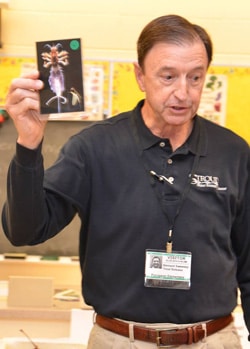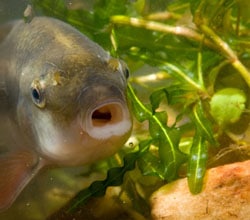STROUD CENTER TACKLES WATERSHED RESTORATION

Bern Sweeney introducing children to aquatic macroinvertebrates at Trout Release Day. Photo: Bev Payton.
To communicate the important role streamside forests play in the health of streams and rivers, Director Bern Sweeney spoke to several groups this spring.
On March 14, he spoke at a public workshop focused on the value of streamside forests. Sweeney presented a convincing, scientifically proven explanation of why it is best to have forests growing along streams. Sponsored by the Chesapeake Bay Foundation, the workshop in Centre Hall, Pa. included discussions about proper use of pesticides, related agriculture regulations and conservation planning.
On March 28, Sweeney presented the program “Trout Grow on Trees” to about 100 students as part of the Trout Release Day project in the Unionville School District’s Pocopson Elementary School. The day concluded a year-long environmental education program designed to foster awareness and knowledge about cold-water conservation in students and encourage continued participation in conservation, management and outdoor recreation programs. Students in the West Chester, Pa. elementary school monitored tank water quality, recorded fish behavior, engaged in stream habitat study and learned to appreciate water resources. View photos of trout release day
And on March 31 and April 2, Sweeney, along with Lamonte Garber, David Wise and Matt Ehrhart, spoke at workshops sponsored by the Stroud Water Research Center’s Watershed Restoration Group in Shartlesville and Myerstown, Pa. The workshops, attended by farmers and conservation workers, discussed important issues like the role of streamside forests in protecting water quality on farms, managing animal concentration areas, manure management plans, and the availability of technical and financial assistance for farmers.
The Watershed Restoration Group, after adding Lamonte Garber to its team in January, is connecting with more landowners and key decision makers than ever to get the word out about farm stewardship, forest buffers and stream restoration. The Stroud Center’s free equine event on Feb. 20 provided one such opportunity, where 60 equine farm managers learned about conservation planning, stream ecology and animal deworming issues.

A golden shiner from a tributary to the Brandywine Creek. Photo: David H. Funk
Garber also spoke to 45 Lancaster-area farmers and 125 attendees at the Union County Conservation District banquet. Additionally, thirty-five municipal officials, consultants and municipal engineers heard the Watershed Restoration Group’s message about best practices for ensuring water quality from David Wise at a Penn State Extension event in Collegeville.
GETTING TO KNOW ROCK SNOT
On March 15, Assistant Director David Arscott presented a seminar titled “Getting to Know Rock Snot (Didymosphenia geminata): a Discussion on the Ecology, Distribution, and Management of an Emerging Nuisance Stream Alga” at the Watershed Congress Along the Schuylkill River held at Montgomery County Community College in Pottstown, Pa. This annual conference is organized by the Delaware Riverkeeper Network.
SOMETHING SMELLS FISHY
How can water temperature and the rate at which it changes affect fish?
Fish molecular ecologist William Eldridge shared what he’s discovered at the annual meeting of the Association of Mid-Atlantic Aquatic Biologists. Traveling to Berkeley Springs, W.Va., he presented “Rate of Temperature Change During Diel Fluctuations as a Source of Stress in Fish” on March 27.



